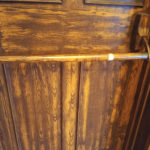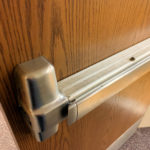 I’ve been invited to join a few Facebook groups lately, and I’m flattered to be included as an honorary member even though I’m not a union carpenter, a locksmith, or an AHJ. Sometimes I can’t resist asking for permission to share a photo posted in one of these groups – there are so many good (or bad!) ones.
I’ve been invited to join a few Facebook groups lately, and I’m flattered to be included as an honorary member even though I’m not a union carpenter, a locksmith, or an AHJ. Sometimes I can’t resist asking for permission to share a photo posted in one of these groups – there are so many good (or bad!) ones.
Today’s Fixed-it Friday photo was posted by Fran Van Blargan on the Locksmith Nation Facebook page, and when I asked if I could share it here, Fran said, “Absolutely, iDigHardware is my favorite website!” WOOT! WOOT! Thanks Fran!
So…what’s wrong with this picture? What’s the code issue here?
You need to login or register to bookmark/favorite this content.










Is the issue with the push side of the door having surface mounted hardware in the 10″ clear ADA range?
That’s one problem, Dawn, assuming that it’s a manually-operated door (not automatic). 🙂
– Lori
That the strike is not attached directly to the door in accordance with the UL testing?
Great job! That strike is not meant to be used on a pair of doors and it is definitely not supposed to be attached to the head of the panic!
– Lori
It looks like they replaced something because there are holes in the stiles leaving holes in the leading edge and the face of the door. It appears that that a roller strike has been added and mounted to the edge of a panic device. I can’t tell with certainty, but it almost appears as if the door with the top and bottom rod has been fixed in place by pinning it to the aluminum saddle. So if that is the case the roller strike does it’s job capturing the latch on the active leaf, but the remaining leaf with the panic hardware is immobilized giving a new meaning to the phrase “Crash Bar”.
In addition to the non-templated and tested rim strike and the less than 10″ bottom rail, I suspect that the opening won’t meet the opening force limits set in ADA guidelines unless there is adequate for the two leaves to operate truly independently. If in opening the vertical rod leaf, the rim leaf also has to move then the user will have the combined opening force of both closers to overcome.
Would not the attachment of the strike to the lockset actually void the UL listing of the both the exit device and strike? Other than the stuff talked about here, this seems pretty creative (assuming of course, it works). Looks like a prototype for a new type of locking device:)
Yes Jim, it would void the listing, unless this is a listed application that I don’t know about.
– Lori
I have to agree with you Jim! Not only is it creative but the workmanship of it is good. That is very difficult application with the narrow stiles. Realistically this will probably hold up better than some of the double door strikes that I have seen. This isn’t a rated door being that it is Aluminum, so that is not an issue; and Lori can correct me if I am wrong but technically they have an ADA compliant door in the opening by having the rim device. The “inactive” door is not ADA compliant but the Active door is. Not all doors in a building have to be ADA compliant….